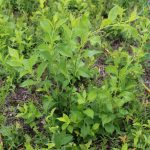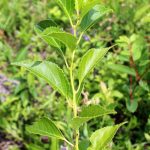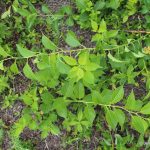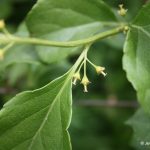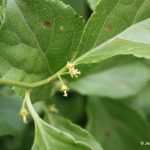Oriental bittersweet
Prepared by Jennifer L. D’Appollonio, Assistant Scientist, University of Maine, Orono, ME 04469. Updated April 2019.
Scientific name: Celastrus orbiculatus Thunb.
Common name(s): oriental bittersweet, oriental staff vine, Asian bittersweet, Chinese bittersweet
Link(s): USDA PLANTS Profile, Go Botany
Images: (to see enlargements [PC]: click on image, then right click and choose “view image”)
- along edge of blueberry field
- vining growth habit
- young non-woody stem in wild blueberry field
- in flower, late June
- small greenish flowers are in leaf axils
Description:
– perennial
-deciduous
-climbing woody vine
-can grow to a length of 60 feet
-the bark is dark brown and striated
-the twigs are smooth and light gray- dark brown
-leaves are
- alternate
- elliptical-circular
- light green
- 2-5 inches long
-flowers and greenish-white and bloom from may-early june
-small globose fruit ripen to yellow and split to show the red berries
– considered invasive in many states
-can girdle and kill trees
– may be confused with native American bittersweet, which has longer flower clusters at the tips of stems, not in the leaf axils. The two species will also hybridize with each other; see left sidebar on Go Botany webpage
Wildlife Benefits:
-birds and mammals eat the fruit
Habitat:
-disturbed sites
-fields
-road edges
Natural History:
-native to China
-was introduced in 1860 for ornamental use
Sources:
The University of Georgia – Center for Invasive Species and Ecosystem Health. “Oriental Bittersweet: Celastrus Orbiculatus (Celastrales: Celastraceae).” Invasive Plant Atlas of the United States, National Parks Service, 2018, www.invasiveplantatlas.org/subject.html?sub=3012.



